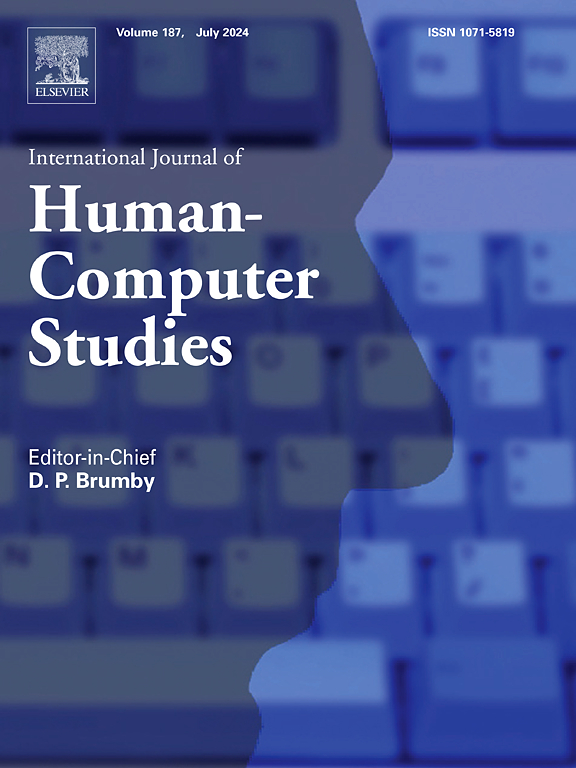Traceable teleportation: Improving spatial learning in virtual locomotion
IF 5.3
2区 计算机科学
Q1 COMPUTER SCIENCE, CYBERNETICS
International Journal of Human-Computer Studies
Pub Date : 2024-11-02
DOI:10.1016/j.ijhcs.2024.103399
引用次数: 0
Abstract
In virtual reality, point-and-teleport (P&T) is a locomotion technique that is popular for its user-friendliness, lowering workload and mitigating cybersickness. However, most P&T schemes use instantaneous transitions, which has been known to hinder spatial learning. While replacing instantaneous transitions with animated interpolations can address this issue, they may inadvertently induce cybersickness. To counter these deficiencies, we propose Traceable Teleportation (TTP), an enhanced locomotion technique grounded in a theoretical framework that was designed to improve spatial learning. TTP incorporates two novel features: an Undo-Redo mechanism that facilitates rapid back-and-forth movements, and a Visualized Path that offers additional visual cues. We have conducted a user study via a set of spatial learning tests within a virtual labyrinth to assess the effect of these enhancements on the P&T technique. Our findings indicate that the TTP Undo-Redo design generally facilitates the learning of orientational spatial knowledge without incurring additional cybersickness or diminishing sense of presence.
可追踪的远程传送:改进虚拟运动中的空间学习
在虚拟现实中,"定点传送"(P&T)是一种运动技术,因其方便用户、降低工作量和减轻晕机感而广受欢迎。然而,大多数 P&T 方案都使用瞬时转换,这已被认为会阻碍空间学习。虽然用动画插值代替瞬时转换可以解决这个问题,但可能会无意中引起晕机。为了弥补这些不足,我们提出了可追踪远距传物(TTP),这是一种基于理论框架的增强型运动技术,旨在提高空间学习能力。TTP 融合了两个新功能:一个是便于快速前后移动的撤消-重做机制,另一个是提供额外视觉提示的可视化路径。我们在虚拟迷宫中进行了一系列空间学习测试,以评估这些增强功能对 P&T 技术的影响。我们的研究结果表明,TTP "撤销-重做 "设计总体上促进了定向空间知识的学习,而不会引起额外的晕机或降低临场感。
本文章由计算机程序翻译,如有差异,请以英文原文为准。
求助全文
约1分钟内获得全文
求助全文
来源期刊

International Journal of Human-Computer Studies
工程技术-计算机:控制论
CiteScore
11.50
自引率
5.60%
发文量
108
审稿时长
3 months
期刊介绍:
The International Journal of Human-Computer Studies publishes original research over the whole spectrum of work relevant to the theory and practice of innovative interactive systems. The journal is inherently interdisciplinary, covering research in computing, artificial intelligence, psychology, linguistics, communication, design, engineering, and social organization, which is relevant to the design, analysis, evaluation and application of innovative interactive systems. Papers at the boundaries of these disciplines are especially welcome, as it is our view that interdisciplinary approaches are needed for producing theoretical insights in this complex area and for effective deployment of innovative technologies in concrete user communities.
Research areas relevant to the journal include, but are not limited to:
• Innovative interaction techniques
• Multimodal interaction
• Speech interaction
• Graphic interaction
• Natural language interaction
• Interaction in mobile and embedded systems
• Interface design and evaluation methodologies
• Design and evaluation of innovative interactive systems
• User interface prototyping and management systems
• Ubiquitous computing
• Wearable computers
• Pervasive computing
• Affective computing
• Empirical studies of user behaviour
• Empirical studies of programming and software engineering
• Computer supported cooperative work
• Computer mediated communication
• Virtual reality
• Mixed and augmented Reality
• Intelligent user interfaces
• Presence
...
 求助内容:
求助内容: 应助结果提醒方式:
应助结果提醒方式:


